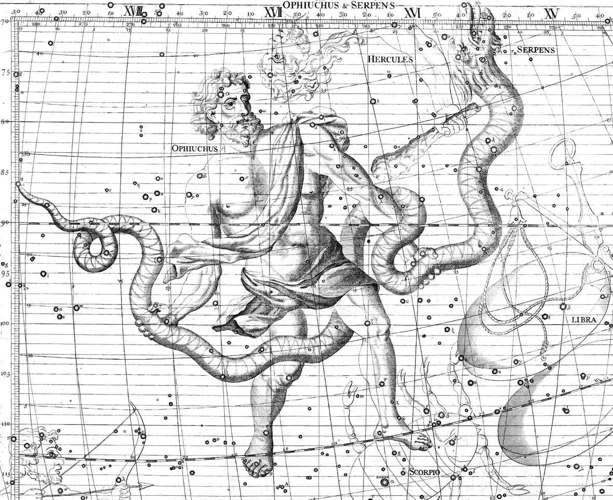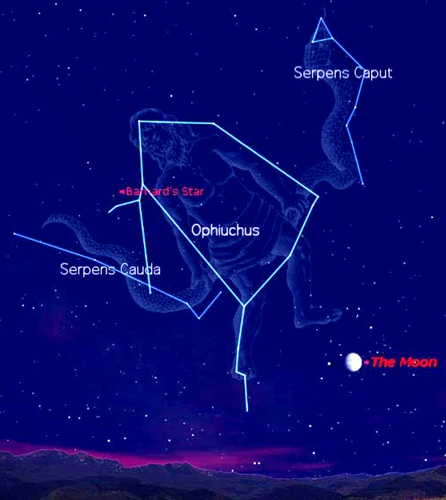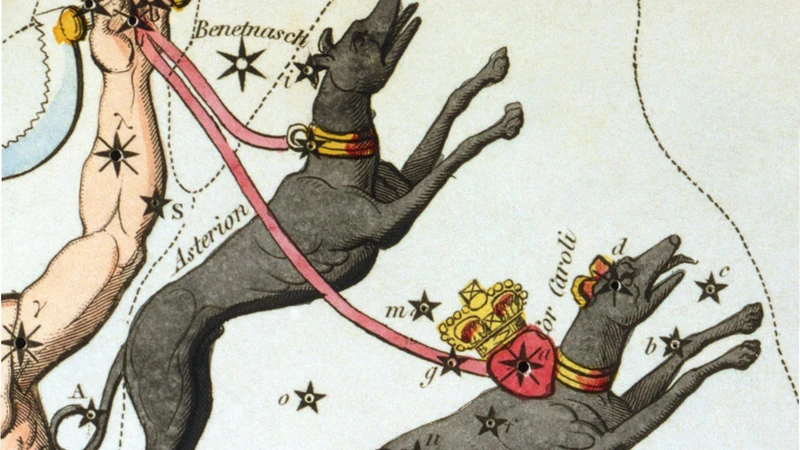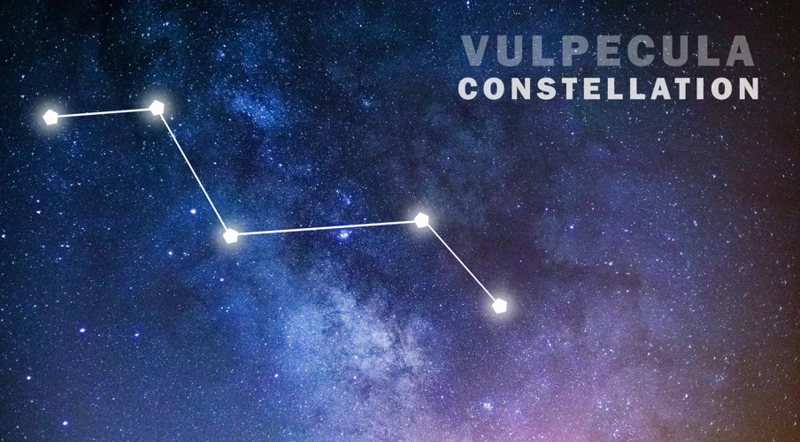When it comes to the zodiac, most people are familiar with the twelve traditional constellations that make up the astrological signs. However, there are several lesser-known zodiac constellations that have a rich history and fascinating mythology. These constellations may not be as well-known, but they still hold significance and can provide a deeper understanding of the celestial world. In this article, we will delve into the mysteries of Ophiuchus, the serpent bearer, Serpens, the serpent, Canes Venatici, the hunting dogs, Lacerta, the lizard, Vulpecula, the fox, and Ara, the altar. Join us on this journey as we explore these captivating zodiac constellations and uncover the hidden stories behind them.
Contents
- Ophiuchus – The Serpent Bearer
- Serpens – The Serpent
- Canes Venatici – The Hunting Dogs
- Lacerta – The Lizard
- Vulpecula – The Fox
- Ara – The Altar
- Conclusion
-
Frequently Asked Questions
- 1. What does the constellation Ophiuchus represent?
- 2. How was Ophiuchus removed from the traditional zodiac?
- 3. What is the significance of the Rod of Asclepius?
- 4. Who is Asclepius in Greek mythology?
- 5. What is the legend of Susanoo in Japanese mythology?
- 6. What traits are associated with those born under the Ophiuchus sign?
- 7. How does Ophiuchus compatibility differ from traditional astrology?
- 8. Can Ophiuchus be found in horoscope forecasts?
- 9. Are there any famous constellations or celestial objects within Ophiuchus?
- 10. Is there a connection between Ophiuchus and other zodiac constellations?
- References
-
Frequently Asked Questions
- What are the lesser-known zodiac constellations?
- How were these constellations discovered?
- What is the mythology behind Ophiuchus?
- Why is Serpens considered a dual nature constellation?
- What are the mythological origins of Canes Venatici?
- What are some notable celestial objects in Canes Venatici?
- What mythological tales are associated with Lacerta?
- How is the fox depicted in various cultures with regards to Vulpecula?
- What is the significance of Ara?
- Are these lesser-known constellations recognized in astrology?
- References
- Read More
Ophiuchus – The Serpent Bearer

Ophiuchus, also known as the Serpent Bearer, is a constellation that lies between Scorpius and Sagittarius, but often goes unnoticed due to its proximity to the more popular astrological signs. The discovery and history of Ophiuchus can be traced back to ancient times when the Babylonians observed the constellation and incorporated it into their zodiac. However, it was later removed from the traditional zodiac as it did not align with the twelve-month calendar system. Despite this exclusion, Ophiuchus still holds significance in astronomy and astrology. In Greek mythology, Ophiuchus is associated with the divine healer Asclepius, who was known for his ability to revive the dead. Asclepius’ story is intertwined with a powerful symbol, the Rod of Asclepius, which is symbolized by a serpent wrapped around a staff. This symbol is now commonly associated with medicine and healing. In Japanese mythology, Ophiuchus is linked to the legend of Susanoo, the god of storms and the sea, who slayed the eight-headed serpent Yamata no Orochi. The tale of Susanoo’s encounter with the serpent is both thrilling and symbolic, representing bravery and triumph over adversity. These mythological connections add depth and intrigue to the enigmatic Ophiuchus constellation. For those intrigued by astrology, Ophiuchus brings a unique energy to the zodiac. Those born under this sign are said to possess traits such as intuition, wisdom, and healing abilities. If you’re curious about how Ophiuchus compatibility compares to traditional astrology, you can explore the topic further. Understanding the elements in horoscope forecasts can further enhance your knowledge of the zodiac and the role Ophiuchus plays in it.
The Discovery and History
The discovery and history of Ophiuchus, the serpent bearer, can be traced back to ancient civilizations who observed and documented the celestial world. The Babylonians, renowned astronomers of their time, acknowledged Ophiuchus as a significant constellation and integrated it into their zodiac signs. However, as astrology evolved and adopted the twelve-month calendar system, Ophiuchus was eventually excluded from the traditional zodiac. Despite its removal, Ophiuchus continued to hold importance in astronomy and astrology. The constellation’s historical significance can be explored through its associations in different mythologies, such as the Greek tale of Asclepius, the divine healer, and the Japanese legend of Susanoo, the god of storms, who triumphed over a great serpent. The discovery and evolving history of Ophiuchus contribute to its mystical allure, making it a captivating subject for those interested in delving deeper into astrology. For more insights into Ophiuchus’ compatibility compared to traditional astrology or the elements in horoscope forecasts, further exploration can provide fascinating perspectives.
The Mythology behind Ophiuchus
The mythology behind Ophiuchus, the Serpent Bearer, is steeped in ancient tales and symbolic representations. In Greek mythology, Ophiuchus is associated with Asclepius, the god of healing and medicine. Asclepius was the son of Apollo and possessed remarkable healing abilities. According to the myth, Asclepius was taught the art of healing by the centaur Chiron. With his newfound knowledge, Asclepius could revive the dead and heal the wounded, leading to an imbalance between life and death. This caught the attention of Hades, the god of the underworld, who complained to Zeus. In response, Zeus struck Asclepius with a thunderbolt, ending his mortal life. To honor his achievements, Zeus placed Asclepius in the stars, forming the constellation Ophiuchus.
In Japanese mythology, Ophiuchus has a different significance. It is associated with Susanoo, the storm god who played a pivotal role in the slaying of the eight-headed serpent, Yamata no Orochi. In this myth, Susanoo encounters a grieving family who had lost several daughters to the serpent. Susanoo agrees to help and devises a plan to defeat Yamata no Orochi. He convinces the family to prepare eight barrels of sake and stand guard, waiting for the serpent to arrive. When the serpent appears, it is enticed by the sake and becomes intoxicated, allowing Susanoo to slay it. The mythology of Ophiuchus in Japanese culture revolves around bravery, heroism, and the triumph of good over evil.
Exploring the mythology behind Ophiuchus adds depth and intrigue to this lesser-known zodiac constellation. Whether you’re interested in understanding Ophiuchus compatibility compared to traditional astrology or gaining insights into the elements in horoscope forecasts, delving into its mythology can provide a greater understanding and appreciation for this enigmatic celestial symbol. To learn more about Japanese mythology and legends, you can visit the link on /japanese-mythology-legends/.
Serpens – The Serpent

Serpens, also known as the Serpent, is an interesting constellation that is divided into two parts: Serpens Caput (the Head) and Serpens Cauda (the Tail). This unique feature gives Serpens a dual nature, symbolizing the ancient symbol of the Ouroboros, a serpent eating its own tail, representing eternal life and cyclicality. The two separate parts of Serpens were once considered as two separate constellations until they were combined into one by the Greek astronomer Ptolemy. In Greek mythology, Serpens is closely associated with the story of Ophiuchus, the Serpent Bearer. Ophiuchus is often depicted holding a serpent, which is represented by the Serpens constellation. Serpens holds a special place in astrological interpretations as well. It is associated with transformation, wisdom, and healing energy. Those born under the influence of Serpens are believed to possess a deep understanding of the cycles of life and have the potential for spiritual growth. In terms of compatibility, understanding how Serpens interacts with other signs can provide valuable insights into relationships. Whether it’s exploring Ophiuchus compatibility or discovering the role of elements in horoscope forecasts, delving into these topics can deepen your understanding of Serpens and its significance in the zodiac.
The Dual Nature of Serpens
The constellation Serpens, also referred to as the Serpent, is a unique constellation that is divided into two parts: Serpens Caput (the Serpent’s Head) and Serpens Cauda (the Serpent’s Tail). This duality is what gives Serpens its intriguing nature. In Greek mythology, Serpens is associated with two distinct stories. The first story involves the healing god Asclepius, who is represented by the constellation Ophiuchus, the Serpent Bearer. Asclepius was said to have learned the art of healing from a serpent and used his knowledge to save countless lives. The serpent, therefore, symbolizes wisdom and healing abilities. The second story tied to Serpens involves the ancient Greek myth of Laocoön. According to the legend, Laocoön was a Trojan priest who tried to warn his fellow Trojans about the Greek deception of the Trojan Horse. As punishment for his actions, the gods sent two serpents to kill Laocoön and his sons. This tragic tale illustrates the darker side of serpents, representing danger and betrayal. The dual nature of Serpens encapsulates both the positive aspects of wisdom and healing, as well as the potential for danger and treachery. Exploring the characteristics of different constellations can offer a greater understanding of astrology. When comparing the compatibility of Ophiuchus with traditional astrology or studying the elements in horoscope forecasts, the inclusion of lesser-known constellations like Serpens brings a new perspective and depth to astrological interpretations. Understanding the symbolism and stories correlated with these constellations can enhance our appreciation for the celestial wonders above us. For those interested in further exploring the compatibility of Ophiuchus with traditional astrology, you can delve into the topic to gain a deeper understanding. Similarly, studying the elements in horoscope forecasts can provide valuable insights into how different constellations contribute to our astrological profiles.
Canes Venatici – The Hunting Dogs

Canes Venatici, also known as the Hunting Dogs, is a small constellation located near the handle of the Big Dipper. Its name originates from Latin, where ‘Canes Venatici’ translates to ‘hunting dogs.’ This constellation was introduced by the Polish astronomer Johannes Hevelius in the 17th century. In ancient mythology, Canes Venatici represents the hunting dogs that accompany the legendary hunter Boötes. According to Greek mythology, Boötes was a skilled celestial hunter who was placed in the sky as a constellation to honor his hunting prowess. The two brightest stars in Canes Venatici, Alpha and Beta Canum Venaticorum, are named Cor Caroli (Latin for ‘heart of Charles’) after King Charles I of England. This honorary naming is attributed to the astronomer Sir Charles Scarborough, who was a physician to the king. Canes Venatici is not associated with any specific zodiac sign but still holds an important place in the night sky. Its location near the Big Dipper makes it easy to spot, and stargazers can appreciate its role in the celestial landscape. If you’re curious about the compatibility of Canes Venatici in astrology, you can explore its relationship with traditional astrology. Additionally, understanding the elements in horoscope forecasts can provide further insights into the influence of Canes Venatici and other constellations in the zodiac.
The Mythological Origins
The mythological origins of Canes Venatici, the hunting dogs, can be traced back to Greek mythology. According to the legend, the constellation represents the two dogs, Chara and Asterion, who aided the famous hunter, Boötes, in his quest to capture the nearby constellation of Ursa Major, the great bear. These loyal hunting dogs were known for their keen sense of smell and unwavering loyalty to their master. In astrology, Canes Venatici is believed to symbolize loyalty, devotion, and the pursuit of goals. If you’re interested in exploring how Canes Venatici compatibility compares to traditional astrology or learning more about the elements in horoscope forecasts, you can delve into those topics as well.
Notable Celestial Objects
Notable Celestial Objects found within the Canes Venatici constellation will surely captivate stargazing enthusiasts. One of the most prominent objects in this constellation is the Whirlpool Galaxy, also known as Messier 51 or NGC 5194. This stunning spiral galaxy is located approximately 23 million light-years away from Earth and is a favorite target for amateur astronomers. Its striking beauty is enhanced by its interaction with a smaller companion galaxy, NGC 5195, which creates a visually mesmerizing effect. Another remarkable object in Canes Venatici is the globular cluster M3, also cataloged as NGC 5272. This cluster contains an impressive collection of tightly packed stars, estimated to be around 500,000 in total. Its brightness and concentrated nature make it a prominent sight in the night sky. The Canes Venatici constellation hosts a variety of other galaxies, such as NGC 4244, a beautiful edge-on spiral galaxy, and NGC 4157, an exquisite barred spiral galaxy. These celestial objects provide astronomers and enthusiasts alike with a wealth of exploration and discovery within the vastness of space. If you’re interested in delving deeper into the world of astrology, understanding Canes Venatici’s influence and compatibility within traditional astrology can be an intriguing topic to explore. Additionally, learning about the role of celestial elements in horoscope forecasts can provide further insights into the intricate world of astrology.
Lacerta – The Lizard

Lacerta, the constellation of the Lizard, may not be the most well-known in the zodiac, but its fascinating mythology and symbolism are worth exploring. In Greek mythology, the story behind Lacerta is associated with the second labor of Heracles (Hercules). As part of his trials, Heracles was tasked with slaying the Lernaean Hydra, a fearsome serpent-like creature with multiple heads. During the battle, a giant crab (Cancer) was sent by the goddess Hera to aid the Hydra. However, Heracles managed to defeat the Hydra and the crab. As a reward for its loyalty, Hera placed the crab among the stars as the constellation Cancer, and the small lizard that had been hiding nearby was also immortalized as the constellation Lacerta. The mythological tale reinforces Lacerta’s association with strength, resilience, and overcoming challenges. In terms of astrological significance, individuals born under the sign of Lacerta are believed to possess characteristics such as adaptability, resourcefulness, and cunning, much like the lizard itself. Exploring the compatibility of Lacerta in relation to traditional astrology can provide further insights into the interactions between different zodiac signs. Additionally, understanding the elements in horoscope forecasts can shed light on how the influence of Lacerta may manifest based on the elemental properties associated with this constellation.
The Mythological Tales
The mythological tales surrounding Ophiuchus are steeped in ancient lore and captivating narratives. In Greek mythology, Ophiuchus is often associated with the god Apollo, a figure known for his healing and prophecy. According to one legend, Apollo taught the art of healing to a mortal named Chiron, who became a renowned teacher of medicine and astrology. Chiron, who is depicted as a centaur, was known for his wisdom and kindness. He used his knowledge to heal both physical and spiritual wounds, and his teachings influenced the practice of medicine in ancient Greece. Another fascinating myth affiliated with Ophiuchus involves the Indian sage Kashyapa. In Hindu mythology, Kashyapa married the serpent goddess, Kadru, who gave birth to a thousand serpent offspring known as the Nāgas. These serpents held great supernatural power and played pivotal roles in many Hindu stories. Kashyapa’s connection to Ophiuchus reinforces the constellation’s association with serpents and healing. These tales showcase the diverse cultural interpretations and significance of Ophiuchus throughout history. Exploring the mythological tales surrounding Ophiuchus can provide a deeper understanding of the constellation and its enduring symbolism in astrology. To learn more about Ophiuchus and how it compares to traditional astrology, you can delve into the topic of Ophiuchus compatibility. Additionally, understanding the elements in horoscope forecasts can shed further light on the zodiac and its intricate dynamics.
Vulpecula – The Fox

Vulpecula, the Fox, is a small but intriguing constellation found in the northern hemisphere. Its name is derived from the Latin word for “little fox.” Despite its size, Vulpecula has its own fascinating mythology and cultural significance across different civilizations. In Greek mythology, the fox is associated with the god Dionysus, who is often depicted wearing a fox skin or transforming into a fox. The fox symbolizes cunning and intelligence in many cultures, and this carries over into the constellation of Vulpecula. One notable celestial object within Vulpecula is the Dumbbell Nebula (M27), which is a planetary nebula located approximately 1,360 light-years away from Earth. This stunning nebula resembles an hourglass or a dumbbell, hence its name. Other notable objects in Vulpecula include the Coathanger Cluster (Brocchi’s Cluster) and the Elephant’s Trunk Nebula. The Coathanger Cluster is a distinctive asterism that resembles a coat hanger, while the Elephant’s Trunk Nebula is a dense concentration of gas and dust, shaped like an elephant’s trunk. Exploring the mysteries of Vulpecula can offer a unique perspective on the celestial world and the various mythological connections attributed to it. If you’re curious about astrology and want to delve deeper into the zodiac, you may be interested in exploring the topic of Ophiuchus compatibility versus traditional astrology. Understanding the elements in horoscope forecasts can also provide valuable insights into the influence of each zodiac sign.
The Fox in Various Cultures
The fox, known as Vulpecula in the zodiac constellation, holds a special place in various cultures around the world. In Japanese folklore, the fox, or Kitsune, is a magical creature believed to possess intelligence and shape-shifting abilities. It is often depicted as a mischievous and cunning being, capable of both good and evil deeds. In Chinese culture, the fox is associated with the mythical creature known as the Nine-Tailed Fox, which is believed to have supernatural powers and wisdom. It is often seen as a symbol of longevity and good fortune. In Native American folklore, the fox is revered for its cleverness and adaptability. The Native American tribes have several legends and stories featuring the fox, portraying it as a trickster figure who outwits other animals with its cunning strategies. In European folklore, the fox is often seen as a symbol of slyness and deceit, as portrayed in stories like “The Fox and the Grapes” by Aesop. These diverse cultural representations of the fox highlight its significance and varying interpretations across different societies. Exploring the role of the fox within these cultures can provide a deeper understanding of their beliefs, values, and mythologies. If you’re interested in how the fox relates to astrology, you can learn more about Ophiuchus compatibility versus traditional astrology. Additionally, understanding the elements in horoscope forecasts can offer further insights into the traits associated with the fox in astrology.
Ara – The Altar

Ara, known as The Altar, is a constellation that holds significant cultural and mythological symbolism throughout history. Depicted as an altar, Ara represents sacrifice and devotion. In Greek mythology, this constellation is associated with the sacrifice made by the gods during the Titanomachy, the war between the Titans and the Olympian gods. According to the myth, the gods built an enormous altar, represented by the Ara constellation, where they made offerings to ensure victory in the battle. This story highlights the importance of sacrifice and dedication in achieving success. In Roman mythology, Ara is often associated with the altar used for religious ceremonies and offerings to the gods. The constellation’s presence in the night sky served as a reminder of the importance of worship and reverence. In astrology, individuals born under the sign of Ara are said to possess qualities of compassion, selflessness, and a strong spiritual connection. These individuals are often seen as natural caregivers and have the ability to provide emotional support to those around them. If you’re interested in exploring how Ara compatibility compares to traditional astrology, you can delve deeper into the topic. Additionally, understanding the elements in horoscope forecasts can provide further insights into the unique traits and characteristics associated with the Ara constellation. Exploring the significance of Ara, the Altar, offers a fascinating glimpse into the cultural, mythological, and astrological aspects that make up this lesser-known zodiac constellation.
The Significance of Ara
The constellation Ara, also known as The Altar, holds its own unique significance in the realm of zodiac constellations. In ancient Greek mythology, Ara represents the sacred altar of the gods, where offerings and sacrifices were made. The name itself is derived from the Greek word “ara” meaning altar. This celestial altar holds a symbolic meaning of devotion and spiritual connection. The Altar is located in the southern hemisphere and was first cataloged by the Greek astronomer Ptolemy in the 2nd century. It is composed of several stars, with the brightest being Beta Arae. The Altar is associated with the constellation Ophiuchus since they are neighboring constellations and share a similar celestial theme. The close proximity of Ara to Ophiuchus enhances its mystical aura and adds depth to the surrounding cosmic narrative. In astrology, Ara is not recognized as an official zodiac sign, but it still holds significance for those who seek to explore the lesser-known constellations. The Altar embodies the concept of devotion, sacrifice, and the act of offering. It serves as a reminder to cultivate a spiritual connection and express gratitude. While Ara may not have specific compatibility readings like traditional astrology signs, its presence in the celestial sphere invites contemplation and introspection. Understanding the elements in horoscope forecasts can shed further light on the cosmic influences that encompass Ara and the other zodiac constellations. Delve into the world of astrology to uncover the hidden mysteries and gain a deeper appreciation for the lesser-known zodiac constellations.
Conclusion

In conclusion, exploring the lesser-known zodiac constellations such as Ophiuchus, Serpens, Canes Venatici, Lacerta, Vulpecula, and Ara can be a fascinating journey into the depths of mythology and astronomy. These constellations may not receive as much attention as the traditional twelve zodiac signs, but they are rich in history and significance. Ophiuchus, the Serpent Bearer, has a long-standing mythology associated with healing and wisdom. The inclusion of elements like the Rod of Asclepius and the story of Susanoo in Japanese mythology adds layers of intrigue to the constellation. Whether you’re interested in exploring Ophiuchus compatibility compared to traditional astrology or understanding the role of elements in horoscope forecasts, delving into these lesser-known constellations can broaden your understanding of the zodiac. So, take a moment to look up at the night sky and appreciate the celestial wonders that go beyond the familiar astrological signs. To learn more about Ophiuchus compatibility and its comparison to traditional astrology, click here. For an in-depth exploration of the elements in horoscope forecasts, click here.
Frequently Asked Questions

1. What does the constellation Ophiuchus represent?
Ophiuchus represents the Serpent Bearer in the zodiac. It is associated with the mythical healer Asclepius and symbolizes healing and wisdom.
2. How was Ophiuchus removed from the traditional zodiac?
Ophiuchus was excluded from the traditional zodiac due to its misalignment with the twelve-month calendar system in use at the time.
3. What is the significance of the Rod of Asclepius?
The Rod of Asclepius, symbolized by a serpent wrapped around a staff, is associated with Ophiuchus and represents healing and medicine. It has become a widely recognized symbol in the field of healthcare.
4. Who is Asclepius in Greek mythology?
Asclepius was a divine healer in Greek mythology, known for his ability to bring the dead back to life. He is often depicted alongside the serpent, which is a symbol of rebirth and renewal.
5. What is the legend of Susanoo in Japanese mythology?
Susanoo is a powerful deity in Japanese mythology who defeated the eight-headed serpent, Yamata no Orochi. This legendary tale showcases Susanoo’s bravery and highlights the triumph of good over evil.
6. What traits are associated with those born under the Ophiuchus sign?
People born under the Ophiuchus sign are said to possess traits such as intuition, wisdom, and healing abilities. They are often seen as passionate individuals with a deep desire to make a positive impact.
7. How does Ophiuchus compatibility differ from traditional astrology?
Ophiuchus compatibility is based on its unique qualities and traits. While it may not have a direct correlation to the traditional astrological signs, exploring Ophiuchus compatibility can provide a new perspective on relationships and compatibility.
8. Can Ophiuchus be found in horoscope forecasts?
Although Ophiuchus is not a commonly included sign in horoscope forecasts, some astrologers do include it. It adds an interesting dimension to astrological readings and can offer additional insights for those born under its influence.
9. Are there any famous constellations or celestial objects within Ophiuchus?
Yes, within the constellation of Ophiuchus, there are notable celestial objects such as the globular cluster Messier 9 and the dark nebula Barnard 68. These objects are of great interest to astronomers and stargazers.
10. Is there a connection between Ophiuchus and other zodiac constellations?
Ophiuchus shares a close proximity to the constellations of Scorpius and Sagittarius. Its location and association with the serpent make it an intriguing neighbor to these well-known zodiac constellations.
References
Frequently Asked Questions

What are the lesser-known zodiac constellations?
The lesser-known zodiac constellations are Ophiuchus, Serpens, Canes Venatici, Lacerta, Vulpecula, and Ara.
How were these constellations discovered?
These constellations were discovered through centuries of observing the night sky and mapping out the patterns of stars.
What is the mythology behind Ophiuchus?
Ophiuchus is associated with the Greek myth of Asclepius, the god of medicine, and is depicted as a serpent bearer.
Why is Serpens considered a dual nature constellation?
Serpens is considered a dual nature constellation because it is split into two parts: Serpens Caput (the serpent’s head) and Serpens Cauda (the serpent’s tail).
What are the mythological origins of Canes Venatici?
Canes Venatici represents the two hunting dogs of the Greek mythological figure, Boötes, who was known as the herdsman.
What are some notable celestial objects in Canes Venatici?
Some notable celestial objects in Canes Venatici include the Whirlpool Galaxy (M51), the Sunflower Galaxy (M63), and the Black Eye Galaxy (M64).
What mythological tales are associated with Lacerta?
Lacerta does not have prominent mythological tales associated with it, as it is one of the later constellations to be introduced.
How is the fox depicted in various cultures with regards to Vulpecula?
In various cultures, the fox symbolizes cunningness, trickery, and intelligence, and Vulpecula represents this aspect of the fox.
What is the significance of Ara?
Ara represents the altar used in ancient religious ceremonies, symbolizing sacrifice and devotion.
Are these lesser-known constellations recognized in astrology?
No, these constellations are not officially recognized in Western astrology, but they hold cultural and historical importance in astronomy.







